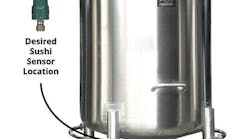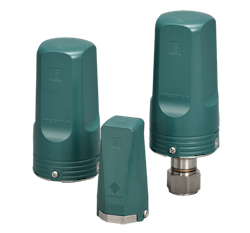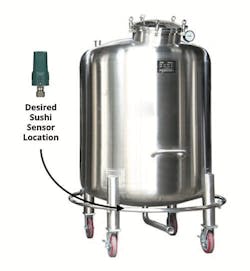During a wireless-pressure-monitoring evaluation process, a major petrochemical company found that portable process units presented unique challenges. The company, which manufactures high-density polyethylene and polypropylene at a polyolefin complex in the United States, maintains 100 portable vessels at the site. These store catalyst and are regularly transported to charge reactors throughout the facility.
In storage, the vessels are connected to a header that maintains a constant nitrogen (N2) pressure. The N2 prevents moisture from entering and contaminating the catalyst. Once a vessel is disconnected from the pressurized N2 header for transportation to the charging area, ensuring no decrease in the N2 pressure due to leakage in tubing or valves is critical.
Operators required a compact, lightweight pressure sensor that would easily connect to the N2 fill line on each vessel without additional supporting hardware. The sensor also needed to be installed in a manner that would prevent collision damage during transportation between the storage area and reactor charging areas. Typically, forklifts move the vessels, often through spaces with very little clearance.
Because vessels could be routed or parked virtually anywhere in the complex, the manufacturer required reliable communications coverage throughout. Buildings and an extensive array of process units and piping presented challenges to wireless signal strength. The wireless network also had to tolerate portability. As vessels move throughout the complex, they could require a handoff from one access point to another, much like mobile devices in a cellular telephone network. Typically, a wireless Internet of Things [IoT] network is designed only to accommodate stationary sensors.
Other requirements included Zone 1 hazardous area certification due to the potentially explosive environment in some locations and operation over a wide temperature range as many of the reactors are located outdoors. The outdoor locations also dictated dustproof and waterproof sensor enclosures.
Among the least-challenging requirements for wireless IoT technology was the maximum N2 pressure reading interval of once per hour. Because checking the pressure is critical, the operations team preferred readings actually take place more often. That would allow the operations staff to take corrective action to prevent loading wet, contaminated catalyst into a reactor, thus eliminating a costly production loss and catalyst replacement.
Figure 1. The pressure sensor is lightweight and approved for Zone 1 hazardous areas.
In the existing process, a technician periodically reads a pressure gauge on each vessel. For 100 vessels, that is labor-intensive and poses the risk of too long an interval between manual readings.
The lack of electrical power on the portable vessels mandated self-powered sensors. All the battery-powered sensors under consideration could manage power use in a way that allows multiple-year battery life at the required reading interval. With an increasing emphasis on reducing maintenance spending, the operations team desired the longest possible battery life.
This wireless IoT project is part of company-wide initiatives to improve productivity and safety. A key aspect focused on the evolving workforce. While reducing costs, plant managers are responsible for enhancing workforce safety, incorporating new skillsets and expanding training programs. As veteran staff who perform manual gauge-reading rounds retire, a new generation whose skillsets include the IoT is arriving on the scene.
The Solution
Physical size and weight constraints disqualified many of the prospective options. Even today’s compact versions of traditional explosion-proof pressure transmitters turned out to be too large and heavy. They not only required additional mounting hardware but also their sizes presented risks of collision damage during transportation. Many wireless HART devices posed the same problems.
The options that did qualify in terms of size and weight presented a wide variety of network architectures and trade-offs. Of those with proven, complex-wide coverage, most required infrastructure such as gateways and access points.
Yokogawa’s Sushi Sensor (Figure 1) emerged as an ideal solution for the application. The product is certified as explosion-proof for installation in Zone 1 hazardous areas. The IP 66/67 enclosure is dustproof and waterproof. The operating temperature range is -40–85°C (-40–185°F). Compact and lightweight, the Sushi Sensor enabled a simplified installation via a tee connection to the pressure line and a block valve (Figure 2). No additional brackets or mounting hardware were required.
From October 2021 to February 2022, 100 Sushi sensors were installed in two phases.
The Sushi Sensor network requires far less infrastructure than others, including Wireless HART, the primary challenger. A site survey confirmed that, using only a single gateway, the Sushi Sensor’s long-range LoRaWAN network provides complete coverage across the entire complex. All other networks required varying numbers of devices such as access points, repeaters and gateways.
LoRaWAN is among the low-power wide-area (LPWA) network protocols attracting attention in IoT wireless sensor communication systems. LoRaWAN is an open communication standard promoted by the LoRa Alliance, which comprises more than 500 IoT companies and end-users worldwide.
LoRaWAN has excellent sensitivity reception and radio interference resistance. In ideal conditions, LoRaWAN offers a communication distance of six miles (10 km) or more. Even in a facility full of buildings and process infrastructure, LoRaWAN ensures long distance communication over one kilometer between sensors and a gateway. In a “pipe jungle,” LoRaWAN provides reliable communication as long as the sensors and the gateway are not completely surrounded by metal or concrete structures. LoRaWAN-compliant devices can be installed and operated easily without the need to design wireless routes that require access points or repeaters.
Figure 2. Hookup of sensor requires only a tee connection and block valve.
At the petrochemical complex, the gateway was installed in a concrete, explosion-proof control room but the LoRaWAN network still maintained excellent signal strength to all locations.
The Sushi Sensor also offered a battery life that was among the highest of the options considered. The longer the interval between battery replacements, the lower the long-term maintenance cost. The maintenance team also appreciates that battery replacement is a simple process.
The Yokogawa team offered both on-premise and Cloud options. The manufacturer chose to use the Cloud, which allows operations personnel to securely monitor vessel status via dashboards on personal computers and mobile devices. In addition to the dashboard displays, the system will send a live e-mail alert for low pressure in any vessel.
The return-on-investment versus risk was positive. The manufacturer determined that preventing a single incident of loading wet catalyst into a reactor justified the deployment cost of the entire wireless monitoring system.
A Great Choice
While the original Sushi Sensor was designed for advanced, predictive asset management applications in conjunction with an artificial-intelligence/machine-learning environment, the Sushi pressure sensor clearly suited the portable vessel monitoring application due primarily to its simplicity. It provided a variety of important benefits.
KEVIN L. FINNAN is Goshen, Ct.-based market intelligence and strategy advisor for Yokogawa. Email him at [email protected].




